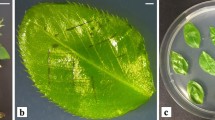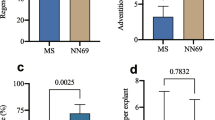Abstract
The effects of antibiotics commonly used in Agrobacterium-mediated transformation were studied on Pinus pinaster tissues. Embryogenic tissue growth from three embryogenic lines and adventitious bud induction from cotyledons from three open-pollinated seed families were analysed. Cefotaxizme, carbenicillin and timentin commonly used for Agrobacterium elimination, at concentrations of 200–400 mg l −1 did not inhibit the embryogenic tissue growth on filter paper nor as clumps. Adventitious bud induction and bud number were significantly reduced for one of the tested families when using 400 mg l−1 cefotaxime or timentin. The selection agent kanamycin significantly inhibited growth of embryogenic tissue on filter paper in all the embryogenic lines␣and concentrations tested (20–50 mg l−1). Kanamycin also inhibited growth of embryogenic clumps after two subcultures at 5–50 mg l−1. In␣cotyledons, kanamycin inhibited adventitious bud␣formation in the three seed families used, regardless of the concentrations tested (5–25 mg l−1). There was a significant effect of the seed family on the bud induction and the number of adventitious buds produced. From the results obtained, we propose the use of timentin to eliminate Agrobacterium in transformation experiments, at concentrations of 400 mg l−1 for embryogenic tissues and of 300 mg l−1 for cotyledons. For selection of transformed tissues carrying the kanamycin resistance gene, kanamycin should be used at 20 mg l−1 for embryogenic tissues on filter paper, at 5 mg l−1 when clumps are in direct contact with the selection medium, and bellow 5 mg l−1 for adventitious bud induction.
Similar content being viewed by others
Abbreviations
- BA:
-
6-benzyladenine
- CH:
-
Casein hydrolysate
- 2,4-D:
-
2,4-dichlorophenoxyacetic acid
- FW:
-
Fresh weight
- NAA:
-
Naphthalene acetic acid
- PGR:
-
Plant growth regulators
References
Cerda F, Aquea F, Gebauer M, Medina C, Arce-Johnson P (2002) Stable transformation of Pinus radiata embryogenic tissue by Agrobacterium tumefaciens. Plant Cell Tiss Org Cult 70:251–257
Charity JA, Holland L, Donaldson SS, Grace L, Walter C (2002) Agrobacterium-mediated transformation of Pinus radiata organogenic tissue using vacuum-infiltration. Plant Cell Tiss Org Cult 70:51–60
Conover WJ (1999) Practical nonparametric statistics. Wiley, New York
Ellis DD, Lazaroff WR, Roberts DR, Flinn BS, Webb DT (1989) The effect of antibiotics on elongation and callus and bud formation from embryogenic tissue of Picea glauca. Can J For Res 19:1343–1346
Grant JE, Cooper PA, Dale TM (2004) Transformed Pinus radiata from Agrobacterium tumefaciens-mediated transformation of cotyledons. Plant Cell Rep 22:894–902
Gupta PK, Durzan DJ (1985) Soot multiplication from mature trees of Douglas fir (Pseudotsuga menziesii) and sugar pine (Pinus lambertiana). Plant Cell Rep 4:177–179
Holford P, Newbury HJ (1992) The effects of antibiotics and their breakdown products on the in vitro growth of Antirrhinum majus. Plant Cell Rep 11:93–96
Holland L, Gemmell JE, Charity JA, Walter C (1997) Foreign gene transfer into Pinus radiata cotyledons by Agrobacterium tumefaciens. NZ J For Sci 27:289–304
Hood EE, Clapham DH, Ekberg I, Johanson T (1990) T-DNA presence and opine production in tumors of Picea abies (L.) Karst induced by Agrobacterium tumefaciens A281. Plant Mol Biol 14:111–117
Humara JM, Ordás RJ (1999) The toxicity of antibiotics and herbicides on in vitro adventitious shoot formation on Pinus pinea L. cotyledons. In Vitro Cell Dev Biol-Plant 35:339–343
Humara JM, López M, Ordás RJ (1999) Agrobacterium tumefaciens-mediated transformation of Pinus pinea L. cotyledons: an assessment of factors influencing the efficiency of uidA gene transfer. Plant Cell Rep 19:51–58
Klimaszewska K, Lachance D, Pelletier G, Lelu M-A, Séguin A (2001) Regeneration of transformed Picea glauca, P. mariana, and P. abies after cocultivation of embryogenic tissue with Agrobacterium tumefaciens. In Vitro Cell Dev Biol 37:748–755
Le VQ, Belles-Isles J, Dusabenyagasani M, Tembray FM (2001) An improved procedure for production of white spruce (Picea glauca) transformed plants using Agrobacterium tumefaciens. J Exp Bot 52:2089–2095
Levée V, Lelu M-A, Jouanin L, Cornu D, Pilate G (1997) Agrobacterium tumefaciens-mediated transformation of hybrid larch (Larix kaempferi X L. decidua) and transformed plant regeneration. Plant Cell Rep 16:680–685
Levée V, Garin E, Klimaszewska K, Séguin A (1999) Stable genetic transformation of white pine (Pinus strobus L.) after cocultivation of embryogenic tissues with Agrobacterium tumefaciens. Mol Breed 5:429–440
López M, Humara JM, Rodríguez R, Ordás RJ (2000) Factors involved in Agrobacterium tumefaciens-mediated gene transfer into Pinus nigra Arn. ssp. Salzmannii (Dunal) Franco. Euphytica 114:195–203
Miguel C, Gonçalves S, Tereso S, Marum L, Oliveira MM (2004) SE from 20 open-pollinated seed families of Portuguese plus trees of maritime pine. Plant Cell Tiss Org Cult 76:121–130
Mihaljević S, Perić M, Jelaska S (2001) The sensitivity of embryogenic tissue of Picea omonika (Panč.) Purk. to antibiotics. Plant Cell Tiss Org Cult 67:287–293
Mohammed GH, Dunstan DI, Thorpe T (1986) Influence of nutrient medium upon shoot initiation on vegetative explants excised from 15 to 18-year-old Picea glauca. NZ For Sci 16:297–305
Sarma KS, Evans NE, Selby C (1995) Effect of carbenicillin and cefotaxime on somatic embryogenesis of Sitka spruce (Picea sitchensis (Bong.) Carr.) J Exp Bot 46:1779–1781
Schmitt F, Oakeley EJ, Jost JP (1997) Antibiotics induce genome-wide hypermethylation in cultured Nicotiana tabacum plants. J Biol Chem 272:1534–1540
Tereso S, Zoglauer K, Miguel C, Oliveira MM (2003) Genetic engineering as a tool for studies of nitrogen metabolism in maritime pine. In: International Congress Tree Biotechnology, June 2003, Ümea, Sweden
Tereso S (2005) In vitro culture systems for clonal propagation and genetic transformation of Pinus pinaster (Sol. ex Ait.). PhD Dissertation, Universidade Nova de Lisboa, Instituto de Tecnologia Química e Biológica, Oeiras, Portugal
Trontin J-F, Harvengt L, Garin E, Lopez-Vernaza M, Arancio L, Hoebeke J, Canlet F, Pâques M (2002) Towards genetic engeneering of maritime pine (Pinus pinaster Ait.). Ann For Sci 59:687–697
Tsang EWT, David H, David A, Dunstan DI (1989) Toxicity of antibiotics on zygotic embryos of white spruce (Picea glauca) cultures in vitro. Plant Cell Rep 8:214–216
Verbist L, Verhaegen J (1986) Susceptibility of tricarcillin-resistant gram-negative bacilli to different combination of tricarcillin and clavulanic acid. J Antimicrob Chemother 17:7–15
Wenck AR, Quinn M, Whetten RW, Pullman G, Sederoff R (1999) High-efficiency Agrobacterium-mediated transformation of Norway spruce (Picea abies) and loblolly pine (Pinus taeda). Plant Mol Biol 39:407–416
Zar JH (1999) Biostatistical analysis. Prentice-Hall, Upper Saddle River, NJ
Acknowledgments
This research was supported by Fundação para a Ciência e Tecnologia (FCT) and the III Framework Programme of the European Community, through grants SFRH/BD/1186/2000 and SFRH/BPD/14964/2004 and Project POCTI/AGR/57157/2004. Estação Florestal Nacional (EFN) is acknowledged for making plant material available.
Author information
Authors and Affiliations
Corresponding author
Rights and permissions
About this article
Cite this article
Tereso, S., Miguel, C., Maroco, J. et al. Susceptibility of embryogenic and organogenic tissues of maritime pine (Pinus pinaster) to antibiotics used in Agrobacterium-mediated genetic transformation. Plant Cell Tiss Organ Cult 87, 33–40 (2006). https://doi.org/10.1007/s11240-006-9130-2
Received:
Accepted:
Published:
Issue Date:
DOI: https://doi.org/10.1007/s11240-006-9130-2




